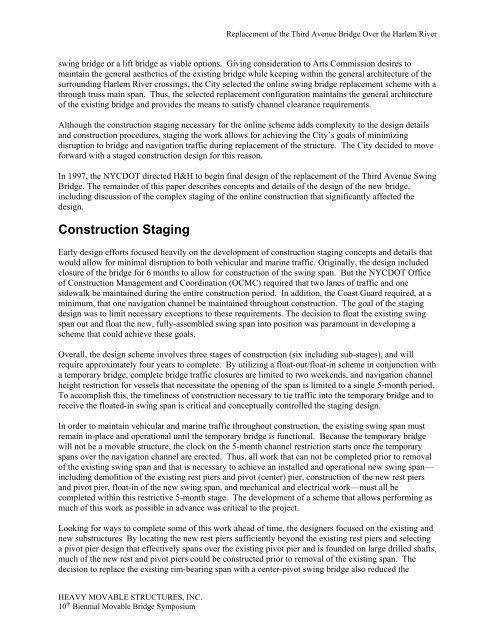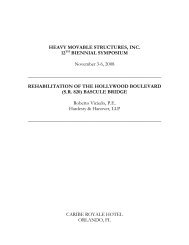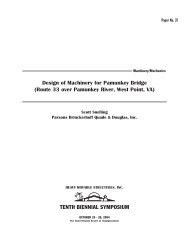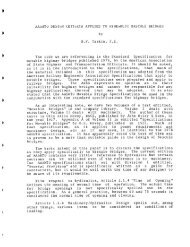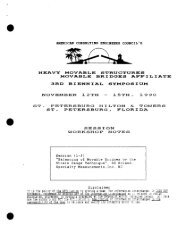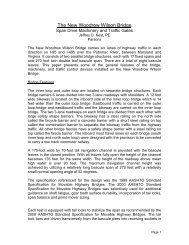HMS 10th Biennial Symposium - Heavy Movable Structures, Inc.
HMS 10th Biennial Symposium - Heavy Movable Structures, Inc.
HMS 10th Biennial Symposium - Heavy Movable Structures, Inc.
You also want an ePaper? Increase the reach of your titles
YUMPU automatically turns print PDFs into web optimized ePapers that Google loves.
Replacement of the Third Avenue Bridge Over the Harlem Riverswing bridge or a lift bridge as viable options. Giving consideration to Arts Commission desires tomaintain the general aesthetics of the existing bridge while keeping within the general architecture of thesurrounding Harlem River crossings, the City selected the online swing bridge replacement scheme with athrough truss main span. Thus, the selected replacement configuration maintains the general architectureof the existing bridge and provides the means to satisfy channel clearance requirements.Although the construction staging necessary for the online scheme adds complexity to the design detailsand construction procedures, staging the work allows for achieving the City’s goals of minimizingdisruption to bridge and navigation traffic during replacement of the structure. The City decided to moveforward with a staged construction design for this reason.In 1997, the NYCDOT directed H&H to begin final design of the replacement of the Third Avenue SwingBridge. The remainder of this paper describes concepts and details of the design of the new bridge,including discussion of the complex staging of the online construction that significantly affected thedesign.Construction StagingEarly design efforts focused heavily on the development of construction staging concepts and details thatwould allow for minimal disruption to both vehicular and marine traffic. Originally, the design includedclosure of the bridge for 6 months to allow for construction of the swing span. But the NYCDOT Officeof Construction Management and Coordination (OCMC) required that two lanes of traffic and onesidewalk be maintained during the entire construction period. In addition, the Coast Guard required, at aminimum, that one navigation channel be maintained throughout construction. The goal of the stagingdesign was to limit necessary exceptions to these requirements. The decision to float the existing swingspan out and float the new, fully-assembled swing span into position was paramount in developing ascheme that could achieve these goals.Overall, the design scheme involves three stages of construction (six including sub-stages), and willrequire approximately four years to complete. By utilizing a float-out/float-in scheme in conjunction witha temporary bridge, complete bridge traffic closures are limited to two weekends, and navigation channelheight restriction for vessels that necessitate the opening of the span is limited to a single 5-month period.To accomplish this, the timeliness of construction necessary to tie traffic into the temporary bridge and toreceive the floated-in swing span is critical and conceptually controlled the staging design.In order to maintain vehicular and marine traffic throughout construction, the existing swing span mustremain in-place and operational until the temporary bridge is functional. Because the temporary bridgewill not be a movable structure, the clock on the 5-month channel restriction starts once the temporaryspans over the navigation channel are erected. Thus, all work that can not be completed prior to removalof the existing swing span and that is necessary to achieve an installed and operational new swing span—including demolition of the existing rest piers and pivot (center) pier, construction of the new rest piersand pivot pier, float-in of the new swing span, and mechanical and electrical work—must all becompleted within this restrictive 5-month stage. The development of a scheme that allows performing asmuch of this work as possible in advance was critical to the project.Looking for ways to complete some of this work ahead of time, the designers focused on the existing andnew substructures By locating the new rest piers sufficiently beyond the existing rest piers and selectinga pivot pier design that effectively spans over the existing pivot pier and is founded on large drilled shafts,much of the new rest and pivot piers could be constructed prior to removal of the existing span. Thedecision to replace the existing rim-bearing span with a center-pivot swing bridge also reduced theHEAVY MOVABLE STRUCTURES, INC.10 th <strong>Biennial</strong> <strong>Movable</strong> Bridge <strong>Symposium</strong>


